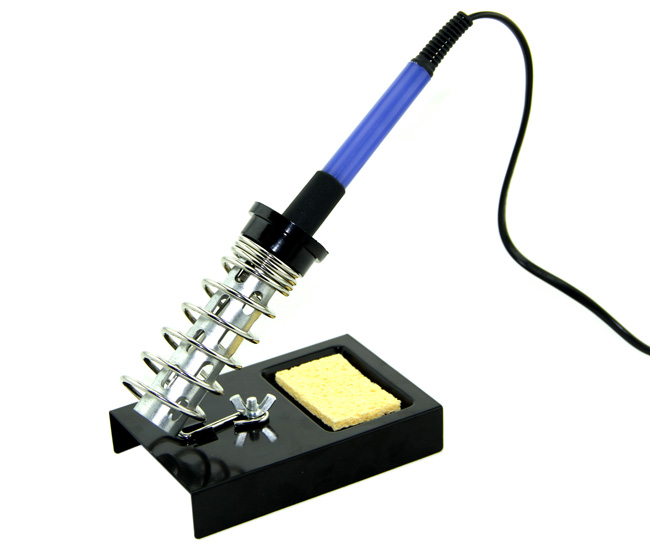These instructions (and videos) give details for making up the AndyPi LCD kit (discontinued 2016), or making your own from scratch. It is very straightforward and just requires some soldering, and wire cutting.
PART 1: Soldering
To make up this kit you will need:
- AndyPi LCD Kit Version
- [Kit comprises: HD44780 LCD, 16-way PCB header pin, 11 x Female-Female jumper wires, 10K potentiometer, solid core wire]
- Soldering Iron
- Solder
- Wire strippers/cutters or knife
- Suitable work surface
1. Cut one of the jumper wires in half, and strip the ends. Solder one of the wires to the top pin of the potentiometer, and solder the other wire to one of (doesn’t matter which) the two lower pins on the potentiometer.
2. Insert 16 pin header into the back of the LCD printed circuit board, and solder into place on the front.
3. Take the short solid core wire, and strip approx 5mm from one end, and 20mm from the other end. Bend into shape, and place on the front of the LCD printed circuit board.
4. Solder the short stripped end to “K” and the long stripped end to “VSS” (i.e. pin numbers 16 & 1).
5. Bend the long stripped end over, and trim as required to form an addition “VSS” pin. It helps to insert one of the jumper wires to do this.
PART 2: Wire up you HD44780 LCD (obviously with the power off!)
On the LCD itself, wire RW to K (using the single female-female wire in AndyPi’s kit), and fit a the contrast-control potentiometer between VO and VSS. (A second pin is created in AndyPi’s kit for VSS, coming from the hard-wired connection to K).
You can turn the potentiometer to change the contrast of the LCD screen to suit, once you have set everything up.
Then, connect the LCD to the Raspberry Pi GPIO pins as follows (This is the same for Model A, Model B rev1 and Model B rev2(. My suggestion is that you print the “Raspberry Leaf” which is a label for the GPIO pins. You can put this over the pins to make identifying them simpler. You can find other diagrams for the GPIO pins, such as this one.
[NOTE: Updated 26/03/13 – Wiring instructions & software (LCDd.conf) have been updated swapping GPIO14 & GPIO18. I’ve swapped these pins so GPIO18 can control the backlight via PWM in Raspbian so you wouldn’t need to swap wires when switching between RASPBMC & Raspbian. If you’ve got a working system, you don’t need to change it, and if you are starting from scratch, you can just ignore this note. But don’t use wiring pre 24th March 2013 and software from post 26th March 2013 or vice versa!]
NOTE 2: Jan 2015: If you want to use the LCD with HiFiberry, you’ll need to reverse these instructions, since HiFiberry uses GPIO 018. You’ll need to edit /etc/LCDd.conf, search for HD44780 and then a few lines underneath there are a list of pin numbers, change A (anode) to an unused pin.
LCD ========== GPIO
VSS —————- GND (pin 6)
VDD —————- +5V (pin 2)
A (Anode) ——— GPIO18 (pin 12) [previously GPIO14]
D7 —————— GPIO14 (pin 8) [previously GPIO18]
D6 —————— GPIO23 (pin 16)
D5 —————— GPIO24 (pin 18)
D4 —————— GPIO25 (pin 22)
E ——————– GPIO08 (pin 24)
RS —————— GPIO07 (pin 26)
That’s it! Your kit is complete – take a look at these other pages which give step by step usage instructions, either for a RaspyFi media player or Controlling with Python under Raspbian.

